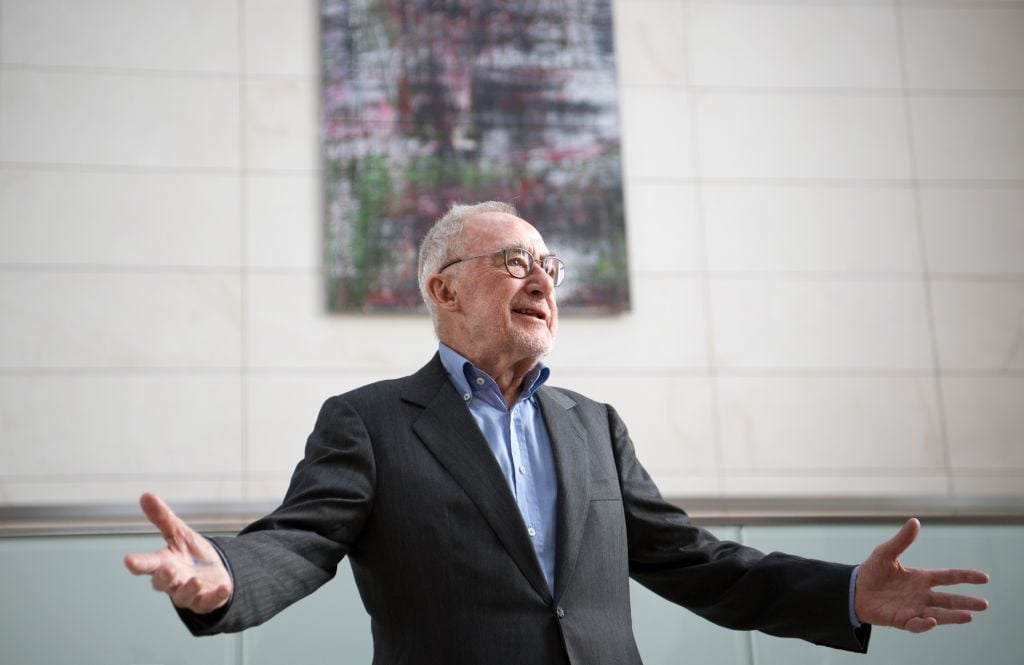Art World
Gerhard Richter Is Permanently Loaning His Holocaust Paintings to Berlin’s National Gallery in Order to Keep Them Off the Market
The series is part of a group of 100 works that Richter's foundation is putting on permanent loan.

The series is part of a group of 100 works that Richter's foundation is putting on permanent loan.

Kate Brown

Gerhard Richter says he never wants his “Birkenau” series of paintings, which remember the Nazi concentration camp, to trade on the art market. That’s why he’s turning them over to the Prussian Cultural Heritage Foundation, which oversees 27 institutions in Germany, for permanent loan.
To celebrate the agreement, Germany’s culture minister, Monika Grütters, the Prussian Cultural Heritage Foundation leader Hermann Parzinger, and Richter’s daughter, Ella Maria Richter, at the Alte Nationalgalerie, one of the museums the foundation oversees.
The “Birkenau” loan, which was made in agreement with Richter’s own foundation, will be part of a group of 100 artworks that will eventually go on view at the Museum of the 20th Century that is currently under construction in Berlin.
“I am delighted that the paintings are coming to Berlin,” Richter said in a statement. Parzinger said the loan is a “dream has come true.”
The four-part “Birkenau” series is on view from today at the recently reopened Alte Nationalgalerie on Museum Island in Berlin as a part of the exhibition “Reflections on Painting,” through October 3. The abstract works were based on four photographs that were secretly taken by a prisoner at the concentration camp, showing burning corpses. The German artist said he struggled to find an appropriate way to recreate the images and, in the end, decided to obfuscate his original figurative paintings by painting over them. Now, only the subtlest elements of the underpainting can be seen.
Germany’s art institutions on Museum Island, including the Alte Nationalgalerie, are opening today for the first time since a second stringent lockdown went into effect in November.

The piece ‘Birkenau’ from 2014 by Gerhard Richter when it was on view at the Frieder Burda Museum in Baden-Baden, Germany in 2016. Photo: Uli Deck/dpa via Getty Images.
The works were recently on view at the Metropolitan Museum in New York as a part of the Richter retrospective “Painting After All.” They had previously hung in Germany’s parliament.
“Richter has had an immense impact on the development of art in recent decades,” said Joachim Jäger, acting director of the Neue Nationalgalerie, where the works will go on view after it reopens this summer, along with a broader group of the 100 works on loan. The works will stay on view there until the Museum of 20th Century Art opens next door in 2027.
“‘Birkenau’ will keep the memory of the Holocaust alive, combined with the question of how to deal with this exemplary crime against humanity, which must always be answered anew,” added Jäger.
Grütters welcomed the collaboration between Richter, who is based in Cologne, and the German capital, calling it “a great gain for the art metropolis” and a “vote of confidence” for the new museum that is currently under construction. Public opinion on the project has been wavering due to delays, exorbitant costs, and an architectural design that some say looks like an Aldi grocery market.
Richter will have a gallery reserved for his loan on the upper floor of the planned museum, near individual galleries dedicated Joseph Beuys, Rebecca Horn, and Sarah Morris.